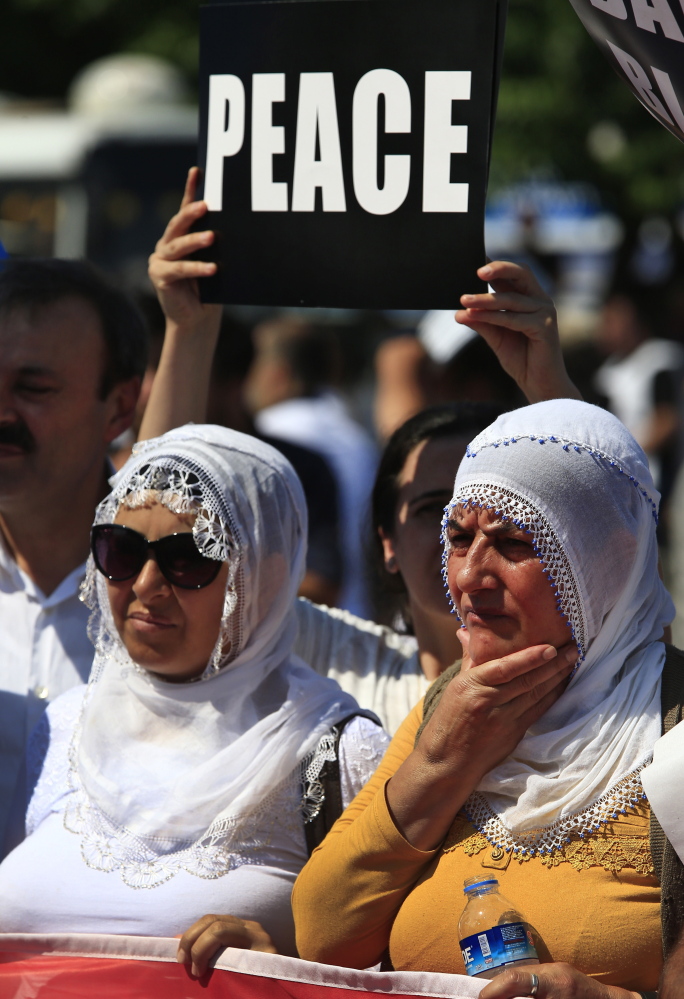Turkey and the United States have agreed on the outlines of a de facto “safe zone” along the Turkey-Syria border under the terms of a deal that is expected to significantly increase the scope and pace of the U.S.-led air war against the Islamic State in northern Syria, according to U.S. and Turkish officials.
The agreement includes a plan to drive the Islamic State out of a 68-mile-long area west of the Euphrates River and reaching into the province of Aleppo that would then come under the control of the Syrian opposition. If fully implemented, it would also bring American planes in regular, close proximity to bases, aircraft and air defenses operated by the Syrian government, and directly benefit opposition rebels fighting President Bashar al-Assad’s regime.
Operations in the targeted area would stop short of meeting long-standing Turkish demands for a full-scale, declared no-fly zone, but the area could eventually become a protected haven for some of the estimated 2 million Syrian civilians who have fled to Turkey.
The first word of the agreement came last week, when Turkey said it had agreed to allow armed U.S. aircraft to fly out of its base at Incirlik. Turkish jets have begun flying missions into northern Syria.
Additional details, including the composition of Syrian opposition forces that are to be inserted on the ground to hold the protected area, are still being worked out, according to the officials, who spoke on the condition of anonymity to discuss the evolving operations.
“When areas in northern Syria are cleared of the (Islamic State) threat, the safe zones will be formed naturally,” Turkish Foreign Minister Mevlut Cavusoglu told journalists in Ankara on Saturday. “People who have been displaced can be placed in those safe areas.”
U.S. officials did not dispute the Turkish description and said U.S. and coalition air cover would effectively operate around the clock as Islamic State targets were located. But they said the United States would not officially designate the area – about 40 miles deep into Syria along the 68-miles stretch of border – a protected zone.
NATO’s secretary general said on Sunday that the alliance’s 28 members will hold consultations on Tuesday in Brussels in response to a Turkish request that followed a suicide bombing in Turkey last week. The consultations are under NATO’s Article 4, allowing any member to convene a meeting when it believes its territorial integrity or security is threatened.
NATO deployed Patriot anti-missile batteries to Turkey in early 2013, after Turkey charged in Article 4 consultations that its citizens had been killed by Syrian government missiles fired across the border and that Syrian planes had violated its airspace.
The Obama administration has long resisted establishing Syrian safe zones, protected by U.S. and coalition air power, and has said its air operations would target only the Islamic State. The Pentagon has maintained that targeting regions of western Syria, near where the government is fighting numerous rebel and militant groups, could provoke a clash with Syrian air defenses that are centered in that area.
Turkey had previously refused use of Incirlik as a base for U.S. air attacks unless the United States agreed to establish a protected zone along the border.
But several aspects of the conflict have changed for both governments since they first formally discussed the issue late last year.
Turkey’s change of heart began about six weeks ago, after a push by the Islamic State in May to capture Azaz, the most vital border crossing for U.S.-backed moderate rebels.
Send questions/comments to the editors.



Success. Please wait for the page to reload. If the page does not reload within 5 seconds, please refresh the page.
Enter your email and password to access comments.
Hi, to comment on stories you must . This profile is in addition to your subscription and website login.
Already have a commenting profile? .
Invalid username/password.
Please check your email to confirm and complete your registration.
Only subscribers are eligible to post comments. Please subscribe or login first for digital access. Here’s why.
Use the form below to reset your password. When you've submitted your account email, we will send an email with a reset code.